It would spur privatized highway construction, destroy farming communities, increase flooding and urban sprawl, and line the pockets of contractors.
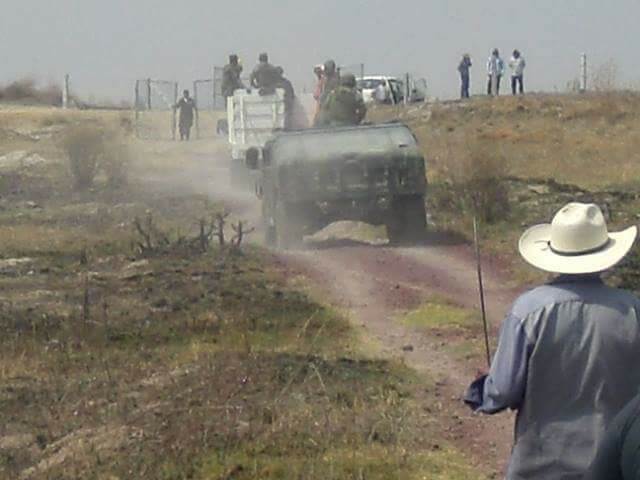
Mexican police forces invade ejidal lands in San Salvador Atenco near Mexico City where campesinos have resisted the expropriation of their lands for a controversial new airport. Photo from the Global Anti-Aerotropolis Movement.
Read “Protestas contra el nuevo aeropuerto de la Ciudad de México” by Johnny Hazard at The Rag Blog en español.
A special report
MEXICO CITY — The federal government of Mexico has begun a project to build a new airport, one of the biggest in the world, in a country where the vast majority of the people have never flown. This project threatens to:
- spur construction of 16 to 19 new highways in the Mexico City-Toluca-Texcoco metropolitan area(s), all privatized from their inception, increasing dependence on the automobile in an area where car ownership has more than doubled in 10 years. Almost all toll roads in Mexico are privately constructed and owned but publicly subsidized. Giveaways of public money to corporations is the raison de’etre of most of the world’s new airport construction;
- increase CO2 emissions (from the planes themselves and from cars and buses that would go much farther than before to get to the airport) in one of the most polluted cities in the world;
- line the pockets of contractors, construction companies, and “starchitects”;
- increase the risks of flooding and exacerbate the drying of lakes and rivers;
- damage or destroy what remains of the farming communities around Mexico City and Texcoco;
- increase suburban sprawl (result of all of the above).
As campesinos of Atenco prepared to commemorate the 10th anniversary of the state and federal attack on their town as revenge for their having defeated the first proposal to build an airport on their farm lands, a skirmish occurred on April 12 (see photo) in which surveyors were escorted onto the lands by a small group of soldiers and a tanqueta (mini-tank). Atenco residents ran them off, removed the surveying stakes, and set up a permanent camp on a local hill.
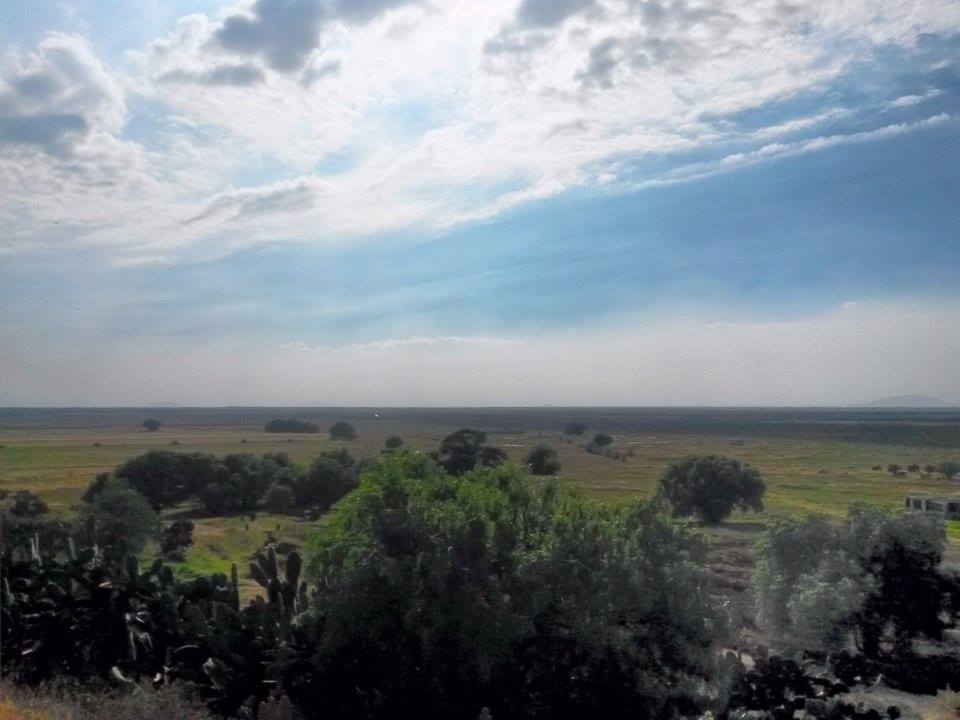
The ejido of Atenco, with the suburb of Ecatepec in the distance. Photos courtesy of high school students in solidarity with Atenco, except where otherwise indicated.”
“Infrastructure” is the mantra of Mexican president Enrique Peña Nieto and his state and local counterparts of other political parties. But they’re not talking about water (unless it’s to divert it toward golf courses and breweries), much less schools: what’s hot now is to offer “incentives” to construct private highways, high rise buildings, and airports.
In Mexico City a small percentage of the population has the funds to pay for a plane ticket.
In Mexico City, where a small percentage of the population has the funds to pay for a plane ticket, the construction of a new airport is all the rage (among politicians, executives and media owners). A second terminal at the current site is less than 10 years old; the existing airport is served by existing highways, other thoroughfares, the subway, and confined-lane buses, and underwent a recent remodeling job.
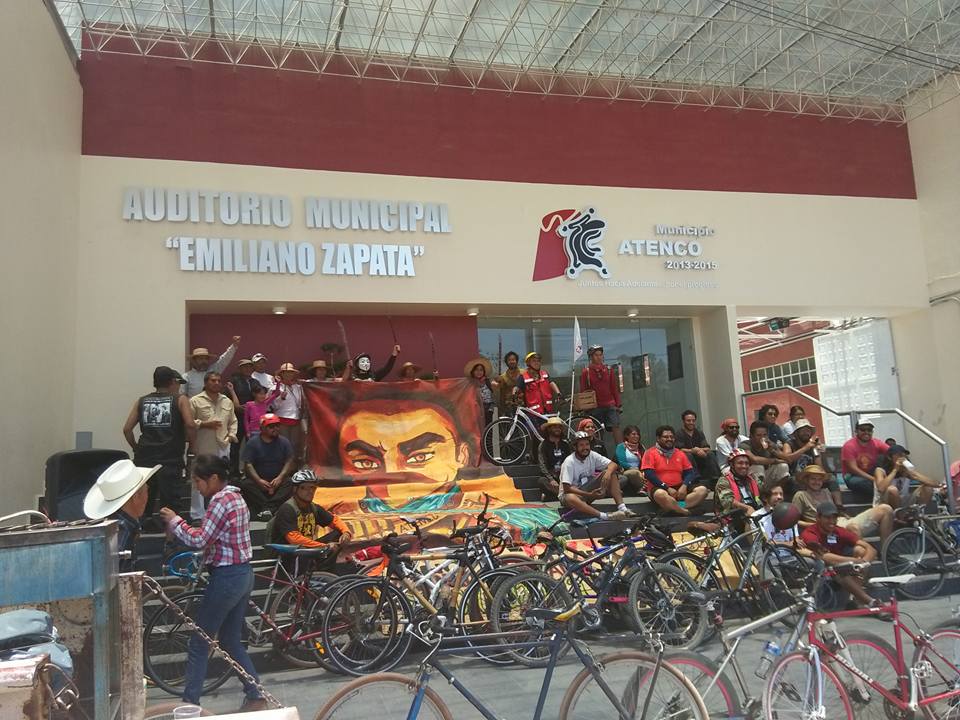
Cyclists protest plans for the airport. Image from Nosotros defendemos a la madre tierra.
When Vicente Fox took office as the country’s first opposition president since the Revolution — he’s since allied himself with the ruling PRI — he attempted to build an airport on communally-held lands in Atenco, outside of Texcoco. (Texcoco is a city of about 100,000 people, about 25 miles northeast of Mexico City. Atenco is an adjacent farming community of about 20,000 people.) Fox’s airport proposal sparked a campesino uprising that damaged his presidency to the point that he had to cancel the project in 2002.
But now, the retooled airport project has become the centerpiece of Peña Nieto’s attempt to salvage his own presidency after government-inflicted human rights atrocities like that of the 43 education students who disappeared in September 2014, in Iguala, Guerrero, and economic scandals like his and his associates’ acquisition of mansions with “loans” from a firm, Higa, that has been favored in no-bid highway and train construction contracts. Higa built and paid for mansions for Angélica Rivera, the wife of Peña Nieto, and Luis Videgaray, a top cabinet official.
Another firm, OHL, based in Spain but which makes lots of its money in Mexico, is accused of massive fraud in Mexico, where it’s tied to the ruling party, the PRI, and in Spain, where it’s also tied to the right-wing governing party, Partido Popular. Recordings in which one OHL executive accuses others, and the company, of fraud were released last year. Around the same time, other recordings revealed that OHL paid for the vacations, in Spain, of the state secretary of transportation and his family.
The company’s stock fell in both countries. In an attempt to cut losses, OHL México sold some assets to an Australian pension fund and other curious buyers. OHL now controls contracts for some of the new airport-related freeways mentioned above and recently revamped its board of directors to include people from the airport authority. The government, instead of cancelling contracts, arranged to have the journalists who denounced this fraud fired. (Carmen Aristegui, dismissed from three radio stations over the years, maintains her program on CNN Español where she filed this report on the subject.)
In May 2006, police raided the town of Atenco and raped, beat, and detained residents.
The farmers, farm workers, and allies who prevented the airport from being built in the first years of this century paid a heavy price for their victory: In May 2006, state and federal police raided the town of Atenco and, according to dozens of witnesses and various human rights organizations, raped, beat, and detained residents and visitors including the Chilean cinema student Valentina Palma, who was sexually assaulted, beaten, and immediately deported. She was about to graduate from film school in Mexico but has not been able to return. Forty-seven women alleged sexual assault; no one has ever been punished.
After mass detentions, Ignacio del Valle, one of the most visible leaders of the anti-airport movement, was sentenced to 102 years in prison, and 10 others received sentences of 30 years. All were released amid public pressure after four years. This police action was a bipartisan collaboration between the outgoing president, Fox, and an up-and-coming governor named Enrique Peña Nieto.
While many were captured and imprisoned, others went into hiding; del Valle’s daughter, América, was eventually able to put herself out of danger by seeking asylum at the Venezuelan embassy.
While the activists were indisposed, new president Felipe Calderón discreetly revived the airport project. (This was against the advice of cabinet member, hydraulic engineer, and former PAN official Jose Luis Luege, who supported a plan to reconstitute the parts of Lake Texcoco that have been dried. The PAN is Partido de Acción Nacional, the conservative party of Fox and Calderón.)
As Ignacio del Valle stated at a recent forum at the Universidad Autónoma de la Ciudad de México: “the violation that many women of Atenco suffered of the most sacred rights of a human being is something that we don’t forget and we don’t pardon. But we don’t hate. In spite of having been tortured in prison, I don’t hate the oppressors.”
Del Valle adds that the Atenco campesinos organized as Frente de los Pueblos en Defensa de la Tierra hope that people will come out to protest during the 10th anniversary of the attack, “not to call us pobrecitos, but to express indignation with us.”
San Salvador Atenco is the “cabecera municipal” of a group of pueblos that include Atenco, Acuexcómoc, Nexquipayac, and others. Behind them is a vast unspoiled area that contains ejidos — communal farmland. The ejido is a figure of the Mexican revolution of 1910-1917 and was an attempt to redistribute land stolen by the pre-revolutionary president Porfirio Díaz and his cronies through a de facto slavery system.
“Our ancestors were peones on the haciendas in this area,” del Valle explains. And before that, pre-colonial, indigenous farmers: Alicia, an older woman in the Atenco community who has a third-grade education and often speaks at public forums, evokes the indigenous roots of Atenco: “This is not a battle. It’s a struggle for our mother earth.”
Campesinos move between the towns and the fields on old bikes.
Campesinos move between the towns and the fields on old bikes to which they strap shovels or machetes. The ejido of Atenco, one of three in the area, has 2,500 hectares on which around 300 people work full-time and others farm in addition to their other occupations — manual in most cases, though there are a few teachers and a dentist.
We visited El Cilantrero, the Cilantro Man, bearer of a Mexican tradition in which people are known by nicknames and almost no one knows their real names. He cultivates seven hectares of cilantro and spinach. This may sound like a hobby farm in U.S. terms, but it’s enough for him and three workers to live on. In 2001, the government under Fox offered seven pesos per square meter for the land that it intended to expropriate. Now the offer has increased exponentially and some have succumbed.
(The ejido system began to be destroyed, quasi-privatized, during the regime of Carlos Salinas in the 1990s in a move, similar to the Indian Allotment Act of 1924 in the U.S., to weaken collective traditions and open land up to settlers and speculators.) Ignacio del Valle remembers 2001: “We never felt that we were poor because we lived in an environment in which nobody had to steal; everybody contributed beans, hogs, etc. That tranquility was broken on October 22,” the day that the Fox administration decreed the expropriation of the ejido of Atenco (which means “on the lake shore” in the Náhuatl language).
A rigged assembly of the ejido took place in June 2014. Goons with no connection to Atenco posed as members of the ejido and hundreds of state police assured that no one would challenge them. The president of the ejido, Andrés Ruíz Méndez, now mayor of Atenco and a local leader of the PRI, called the meeting in a private location with electric fencing and railroaded a vote in favor of selling off the ejido to the federal government in this manner. The assembly lasted 15 minutes.
Fabiola Gutiérrez Quiroz reported on this assembly in Spanish in the alternative newspaper desinformémonos.
Many archaeological treasures are threatened by airport construction.
As Don Rodrigo, a local farmer and member of the movement, showed us the fields from the main hill of Atenco, four men appeared in a pick-up. “We came to see the lizard.” Someone showed them a stone in the shape of a lizard, about eight feet long and with hieroglyphics, one of many archaeological treasures threatened by airport construction. “This is where they want to put the runways,” Rodrigo said. About 50 feet away is “La silla de Nezahualcóyotl,” a rock shaped like a bench where Nezahualcóyotl (“Hungry Wolf”), also known as“the Poet King” — el Rey Poeta — sat and looked out at the valley. He reigned a century before the arrival of the Spanish in 1521and was one of the engineers responsible for the construction of some of the most sophisticated hydraulic and irrigation systems of that era.
The Instituto Nacional de Antropología e Historia (INAH), a government agency ostensibly charged with historical and cultural preservation, concedes that in Atenco there are stone artifacts that date from 8,000 ACE to 700 CE and that there is evidence of the presence of mammoths from the same period. Local activists maintain that there are 1,000 indigenous archaeological sites in Atenco alone. Anthropologists based in Mexico City who ask not to be identified allege that even in the early phases of construction and surveying, crews found and immediately destroyed indigenous artifacts and that the INAH pretended not to notice.
Atenco borders on Texcoco, Ecatepec (an industrialized, highly polluted suburb), and the northeastern part of Mexico City. Lake Texcoco, one of seven lakes in the metropolitan area, dominated this zone until, immediately after the conquest, the Spanish began their ecocidal practices of drying lakes and rivers, thinking that by doing so they controlled flooding.
Farmers predict that the paving of this area will aggravate flooding.
Atenco farmers predict that the paving of this area, one of the few green spaces left within an hour of Mexico City, will aggravate flooding in the city by further increasing hardscape. And local scientists with an organization called Ciéntificos Comprometidos con la Sociedad (Scientists Committed to Society) share this belief and cite a suspicious environmental impact statement that gave a fast-track authorization, at Christmastime, to the project based partly on “neighbor” interviews with residents of Ecatepec, but not of Atenco or Texcoco.
The scientific organization adds that the project violates the regional development plan for greater Texcoco, which mandates the promotion of agricultural activities and prohibits construction over the basin of Lake Texcoco, an official protected natural area.
Similarly, Grupo Aeroportuario de la Ciudad de México and Guinness report that the airport will contain the world’s largest parking lot, supplanting that of the West Edmonton Mall in Alberta, Canada, and offering 20,000 parking places.
The scientists’ group also sounds the alarm about a vague plan to construct an “Aerotrópolis,” an airport city that would include this parking lot and a host of convention and hospitality facilities so that a visit to Mexico would be limited to that area. When the Secretariat of Natural Resources approved the airport project, it “gave a blank check” to this and other aspects whose characteristics are unclear.
The environmental impact statement doesn’t indicate how big the airport city would be, but the Scientists Committed to Society estimate that it would require 3.5 million cubic meters and that it would consume 23 million cubic meters of water per year. “Starchitect” Norman Foster claims the airport project would be self-sufficient in terms of water. He also plans to put a giant tarpaulin under the airport site, and at the same time to elevate it onto a platform to prevent the airport from sinking. (Texcoco is one of the most-rapidly sinking parts of the center of the country.) At the same time, residents of Texcoco, Atenco, and other nearby communities wonder where the projected 125,000 workers will live.
(There is a detailed analysis of the project in Spanish, based on the study of Scientíficos Comprometidos con la Sociedad, in the independent newspaper desinformémonos.)
As a few ejido members cashed their expropriation checks, members of the underworld smelled their money.
Atenco residents speak of how, as a few ejido members cashed their expropriation checks, members of the underworld smelled their money and kidnappings, a previously-unknown phenomenon in the area — Texcoco is one of the safest cities in the state — began to occur. Residents fear what could happen if the project continues and boom town nightmares such as those that have happened in Alberta and North Dakota materialize: exponential growth of towns, environmental devastation, huge influx of young males and concomitant alcohol abuse and sexual violence.
Fox called this land “sterile” and “almost desert” to justify its planned destruction. Atenco residents now grow more than before in what they call an act of resistance, to prove that the land is fertile. Cilantro, lima beans, corn, wheat, spinach, and asparagus are some of the plants they grow for subsistence, sale, and to give away to occasional visitors.
As we left the town and headed into the ejido, Rodrigo said that the area is full of little rivers and showed us two. Over one of them there is a simple, one-lane bridge built recently by local residents with no government assistance. They embedded a machete into the pavement. These are “farm implements, not weapons,”* activists are fond of saying since 2001 when their marches into Mexico City, machetes held high, scandalized the respectable citizenry.
He told us that one of these rivers, now about two feet wide, is destined to be buried by one of the new highways. In the pueblo of Tezoyuca the government began in October to demolish houses, usually without warning, to make room to widen a now-modest highway. (See photographs of this Grapes of Wrath-style demolition of the home of a 71-year-old man in the nearby town of Tezoyuca in the video above.)
Most residents of the Mexico City area who have the purchasing power to buy plane tickets live in or beyond the south and west of the city — exactly opposite of Texcoco, which is about 25 miles northeast of the center of the city. From Tlalpan, a densely populated middle-to-upper income area in the southwest of the city, to Texcoco or Atenco is about two hours by car or in mass transit (buses and trains, making at least three transfers).
One of the reasons that some neighbors support the airport project is, of course, the promise of jobs — as if United Airlines were going to go door to door in low-income, rural communities asking who’s ready to work as a pilot, air traffic controller, or bilingual interpreter. In February, the CROC, a federation of hack unions controlled by the PRI, blocked two highways that serve Texcoco or Atenco for most of a day because the government was not honoring promises to channel jobs to their members.
The contractors
Architect Norman Foster of England recently found one of his airport designs rejected in London. And another London project, to expand Heathrow from two to three runways, is a subject of constant protest, as George Monbiot has reported in The Guardian in a column in which he refers to the Heathrow 13 who chained themselves to block an existing runway and were found not guilty; Monbiot calls them heroes, not hooligans.
The Mexico City airport is projected to have six runways, making it the biggest in the Americas and one of the three biggest in the world. (Some of the other mega airports, such as the one in Dubai, are also Foster-designed. And much of his work has been in oil-rich emirates. See his efforts at greenwashing and self-aggrandizement in the video above.)
One of the main contractors participated in the ‘rebuilding’ of Iraq.
One of the main contractors, Parsons of Pasadena, California, participated in the “rebuilding” of Iraq as part of the U.S. occupying force beginning in 2003, along with companies like Halliburton and Bechtel. But, having accepted acting as accomplice to this U.S. violation of Iraqi sovereignty, Parsons also defrauded the U.S. government and the neocolonial government of Iraq by not building the more than 100 clinics and hospitals it was paid for.
“They also build prisons,” as critical pedagogue and area resident Peter McLaren commented after having looked into Parsons at my request; it appears that for these, the completion rate is higher. Parsons describes itself as “an engineering, construction, technical, and management services firm with revenues of $3.2 billion in 2015. Parsons is a leader in many diversified markets with a focus on infrastructure, industrial, federal, and construction.” (Sic.)
High-speed or other rail alternatives
It’s curious, though not surprising, that a proposed train to Querétaro was halted, due to accusations of corruption and that the airport, with much more potential for environmental devastation and with the same corrupt parties involved, receives little criticism or scrutiny.
Almost all passenger trains in Mexico were eliminated in the 1990s during a phase of the ongoing privatization push under then-president Ernesto Zedillo. A conventional train could get to Querétaro in two hours instead of the highway time of three hours; the cancelled or suspended train would have done it in one hour and would be the gateway to Guadalajara, Monterrey, Laredo (San Antonio, Austin, Dallas), Zacatecas, Leon, Aguascalientes and most of the northern half of the country, thus making it unnecessary to fly to such destinations.
All these cities except the ones in Texas could be reached in less than five hours, much less in some cases, by high-speed rail, and much of the demand for domestic and even international air travel could be supplanted by rail. One rail project is underway: a train from Mexico City to Toluca, the capital of Mexico State, which is now reachable in an hour or more by bus and will reportedly take 39 minutes on the new train, which, like the airport, is immune to recent across-the-board budget cuts.
This train could easily be expanded to Morelia, Lázaro Cárdenas, and the beach towns of Zihuatenejo and Ixtapa, eliminating still more plane trips and offering a good alternative to bus and car transportation toward the west. And Toluca, coincidentally, has a new and under-used airport and is close to the parts of Mexico City where the richest people live.
*Machetes are, in fact, used in all of Mexico for farming and for landscaping in cities; they can be bought at small farm implement stores and even at Wal Mart, but sensationalist media insist on associating them with violence.
Read more of Johnny Hazard’s reporting from Mexico on The Rag Blog.
[Former Minneapolis teacher Johnny Hazard is the Rag Blog Mexico City correspondent. Hazard is a professor at the Universidad Autónoma de la Ciudad de México in Mexico City and is author of Con estos estudiantes: La vivencia en la UACM, a book about that alternative university, and his soon-to-be-released released novel, The Pancho Villa Underground Railroad.]

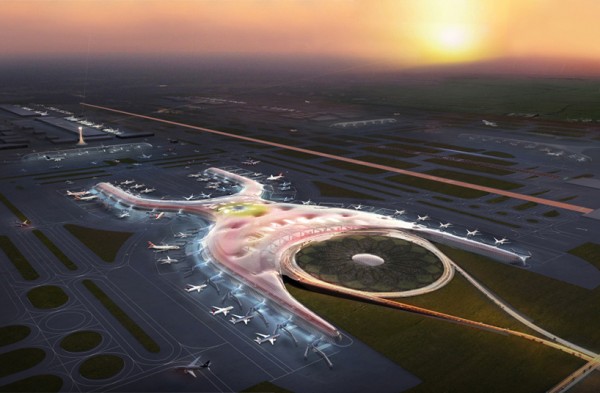
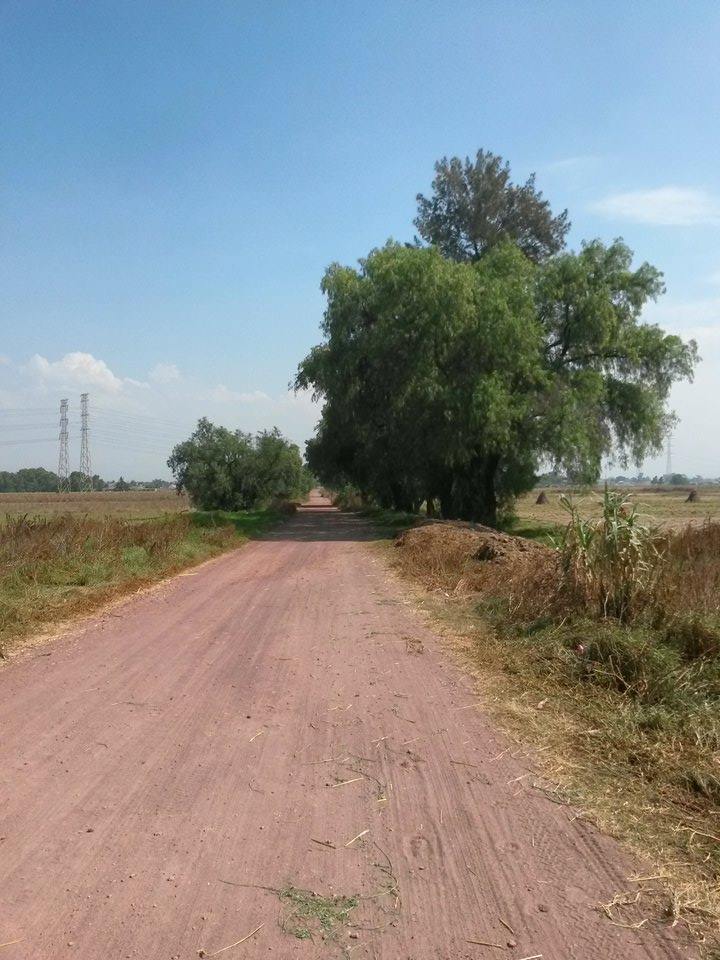

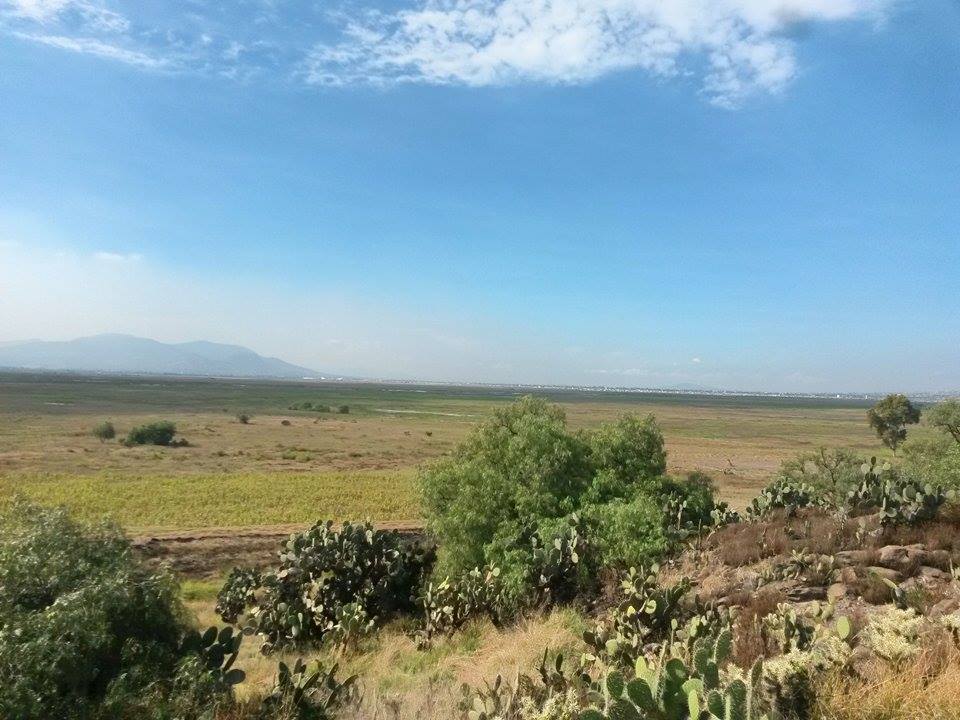

















My god, are they back to this again? What’s next– building the Usumacinta River dams?